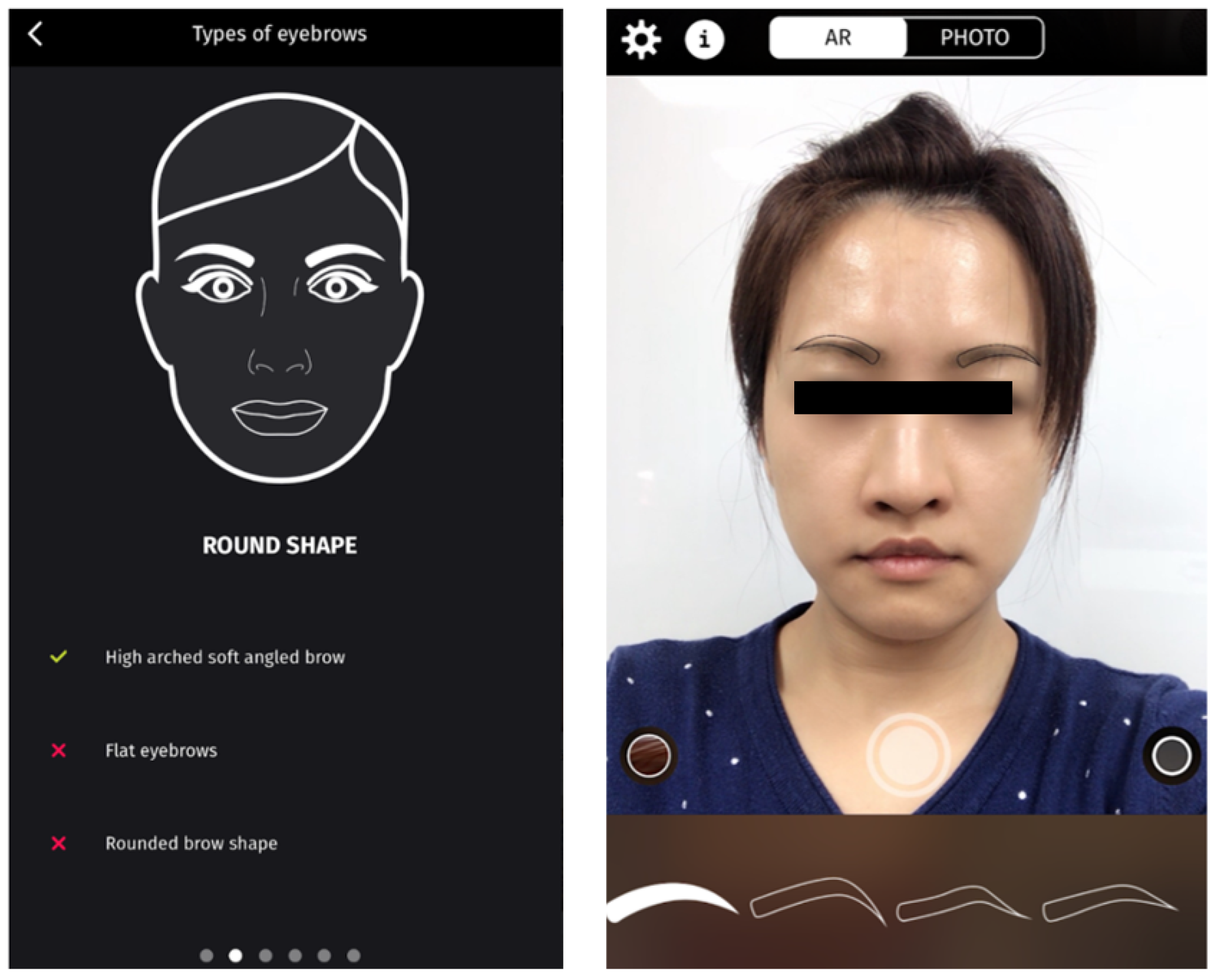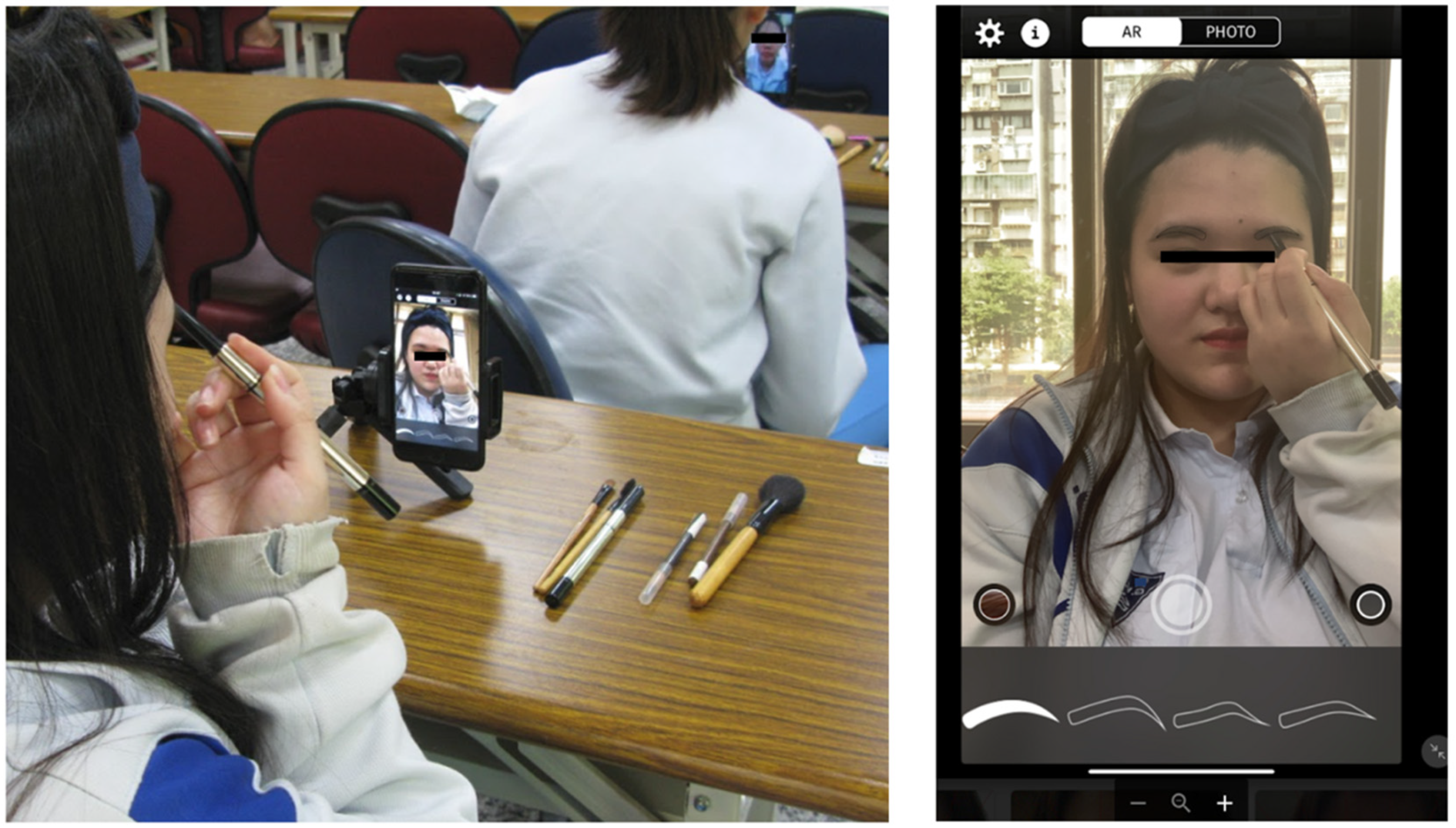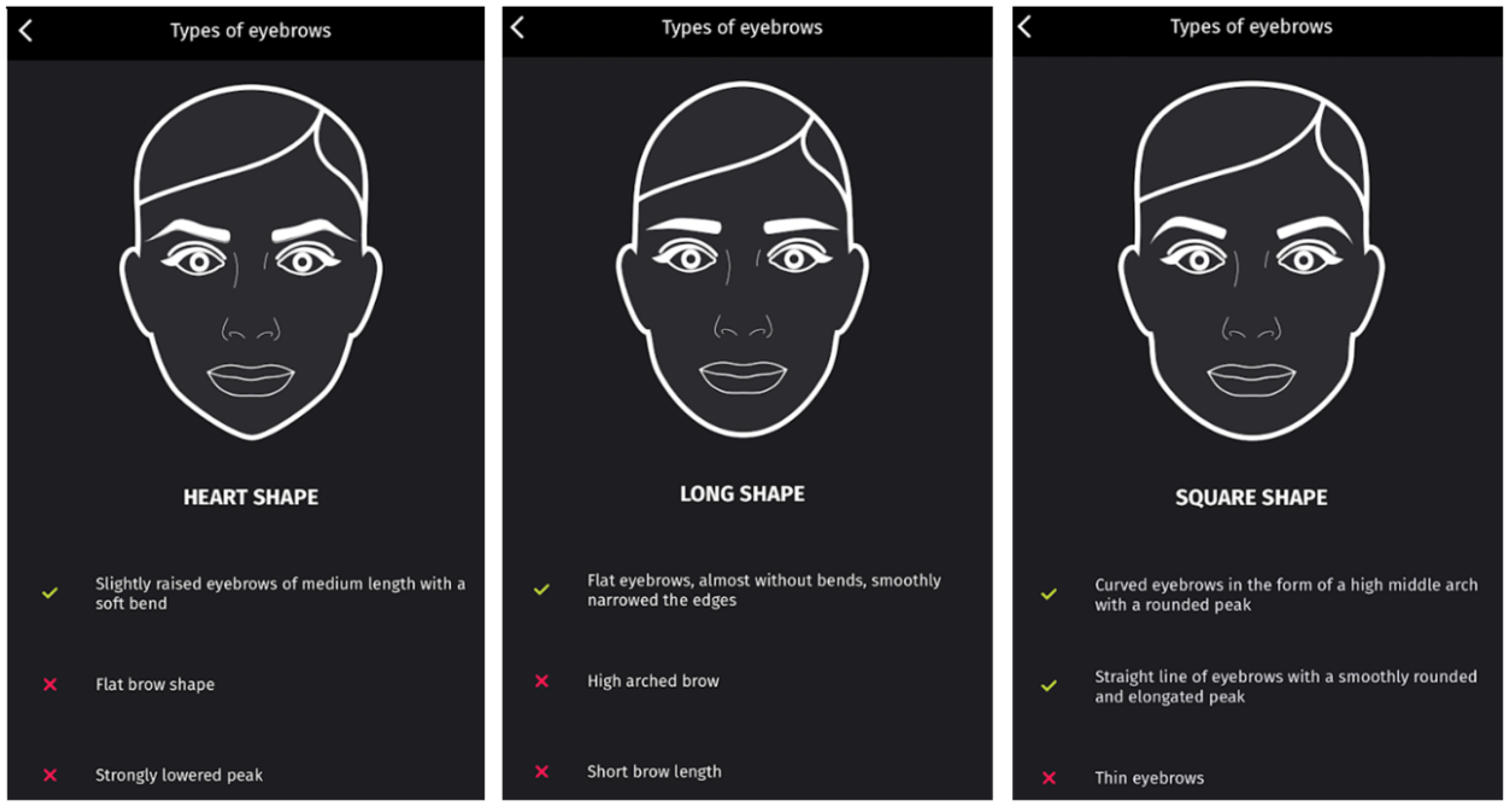Sustainable Education Using Augmented Reality in Vocational Certification Courses
Abstract
1. Introduction
- (1)
- Do the Makeup AR and e-book learning approaches affect the learning effectiveness of students with different learning styles?
- (2)
- Do the Makeup AR and e-book learning approaches affect the learning motivation of students with different learning styles?
- (3)
- Do the Makeup AR and e-book learning approaches affect the self-efficacy of students with different learning styles?
- (4)
- Do the Makeup AR and e-book learning approaches affect the cognitive load of students with different learning styles?
1.1. Teaching in the Makeup Design Certification Course
1.2. AR
2. Materials and Methods
2.1. Research Tools
2.2. Experimental Design
2.2.1. Participants
2.2.2. Experimental Procedure
3. Results
3.1. Learning Effectiveness
3.2. Learning Motivation
3.3. Self-Efficacy
3.4. Cognitive Load
4. Discussion
5. Conclusions
Author Contributions
Funding
Institutional Review Board Statement
Informed Consent Statement
Conflicts of Interest
References
- Bacca, J.; Baldiris, S.; Fabregat, R.; Graf, S. Augmented reality trends in education: A systematic review of research and applications. J. Educ. Technol. Soc. 2014, 17, 133–149. [Google Scholar]
- Shih, J.-L.; Chuang, C.-W.; Hwang, G.-J. An inquiry-based mobile learning approach to enhancing social science learning effectiveness. J. Educ. Technol. Soc. 2010, 13, 50–62. [Google Scholar]
- Anshari, M.; Almunawar, M.N.; Shahrill, M.; Wicaksono, D.K.; Huda, M. Smartphones usage in the classrooms: Learning aid or interference? Educ. Inf. Technol. 2017, 22, 3063–3079. [Google Scholar] [CrossRef]
- Dukic, Z.; Chiu, D.K.; Lo, P. How useful are smartphones for learning? Perceptions and practices of library and information science students from Hong Kong and Japan. Libr. Hi Tech 2015, 33, 545–561. [Google Scholar] [CrossRef]
- Bligh, D.A. What’s the Use of Lectures? Intellect Books: Bristol, UK, 1998. [Google Scholar]
- Ramsden, P. Learning to Teach in Higher Education; Routledge: London, UK, 2003. [Google Scholar]
- Kember, D.; Kwan, K.-P. Lecturers’ approaches to teaching and their relationship to conceptions of good teaching. Instr. Sci. 2000, 28, 469–490. [Google Scholar] [CrossRef]
- Pachler, N.; Evans, M.; Redondo, A.; Fisher, L. Learning to Teach Foreign Languages in the Secondary School: A Companion to School Experience; Routledge: London, UK, 2013. [Google Scholar]
- Kennewell, S.; Parkinson, J.; Tanner, H. Learning to Teach Ict in The Secondary School: A Companion to School Experience; Routledge: London, UK, 2003. [Google Scholar]
- Norris, L. Learning to teach using ict in the secondary school. A companion to school experience. J. Interact. Media Educ. 2015, 2015. [Google Scholar] [CrossRef][Green Version]
- Panjaburee, P.; Hwang, G.-J.; Triampo, W.; Shih, B.-Y. A multi-expert approach for developing testing and diagnostic systems based on the concept-effect model. Comput. Educ. 2010, 55, 527–540. [Google Scholar] [CrossRef]
- Soltani, P.; Morice, A.H.P. Augmented reality tools for sports education and training. Comput. Educ. 2020, 155, 103923. [Google Scholar] [CrossRef]
- Dunleavy, M.; Dede, C.; Mitchell, R. Affordances and limitations of immersive participatory augmented reality simulations for teaching and learning. J. Sci. Educ. Technol. 2009, 18, 7–22. [Google Scholar] [CrossRef]
- Godwin-Jones, R. Augmented reality and language learning: From annotated vocabulary to place-based mobile games. Lang. Learn. Technol. 2016, 20, 9–19. [Google Scholar]
- Ávalos-Ramos, M.; Martínez-Ruiz, M.; Merma-Molina, G. Missing opportunities for gymnastics learning: Voices of secondary education physical education teachers. Ágora Para La Educ. Física Y El Deporte 2015, 17, 130–147. [Google Scholar]
- Elfeky, A.I.M.; Elbyaly, M.Y.H. Developing skills of fashion design by augmented reality technology in higher education. Interact. Learn. Environ. 2021, 29, 17–32. [Google Scholar] [CrossRef]
- Chang, C.-Y.; Lai, C.-L.; Hwang, G.-J. Trends and research issues of mobile learning studies in nursing education: A review of academic publications from 1971 to 2016. Comput. Educ. 2018, 116, 28–48. [Google Scholar] [CrossRef]
- Lonergan, A.R.; Bussey, K.; Mond, J.; Brown, O.; Griffiths, S.; Murray, S.B.; Mitchison, D. Me, my selfie, and i: The relationship between editing and posting selfies and body dissatisfaction in men and women. Body Image 2019, 28, 39–43. [Google Scholar] [CrossRef] [PubMed]
- Ng, W.; Nicholas, H. A framework for sustainable mobile learning in schools. Br. J. Educ. Technol. 2013, 44, 695–715. [Google Scholar] [CrossRef]
- So, H.-J.; Seow, P.; Looi, C.K. Location matters: Leveraging knowledge building with mobile devices and web 2.0 technology. Interact. Learn. Environ. 2009, 17, 367–382. [Google Scholar] [CrossRef]
- Radu, I.; Antle, A. Embodied Learning Mechanics and Their Relationship to Usability of Handheld Augmented Reality. In Proceedings of the 2017 IEEE Virtual Reality Workshop on K-12 Embodied Learning through Virtual & Augmented Reality (KELVAR), Los Angeles, CA, USA, 19 March 2017; IEEE: Piscataway, NJ, USA; pp. 1–5. [Google Scholar]
- Yip, J.; Wong, S.-H.; Yick, K.-L.; Chan, K.; Wong, K.-H. Improving quality of teaching and learning in classes by using augmented reality video. Comput. Educ. 2019, 128, 88–101. [Google Scholar] [CrossRef]
- Hsia, L.-H.; Sung, H.-Y. Effects of a mobile technology-supported peer assessment approach on students’ learning motivation and perceptions in a college flipped dance class. Int. J. Mob. Learn. Organ. 2020, 14, 99–113. [Google Scholar] [CrossRef]
- Lin, Y.-N.; Hsia, L.-H.; Sung, M.-Y.; Hwang, G.-H. Effects of integrating mobile technology-assisted peer assessment into flipped learning on students’ dance skills and self-efficacy. Interact. Learn. Environ. 2018, 27, 995–1010. [Google Scholar] [CrossRef]
- Baek, Y.; Touati, A. Exploring how individual traits influence enjoyment in a mobile learning game. Comput. Hum. Behav. 2017, 69, 347–357. [Google Scholar] [CrossRef]
- Franklin, R.; Smith, J. Practical assessment on the run–ipads as an effective mobile and paperless tool in physical education and teaching. Res. Learn. Technol. 2015, 23. [Google Scholar] [CrossRef]
- Huang, C.-L.; Huang, Y.-M. Facial expression recognition using model-based feature extraction and action parameters classification. J. Vis. Commun. Image Represent. 1997, 8, 278–290. [Google Scholar] [CrossRef]
- Dong, Y.; Woodard, D.L. Eyebrow shape-based features for biometric recognition and gender classification: A feasibility study. In Proceedings of the 2011 International Joint Conference on Biometrics (IJCB), Washington, DC, USA, 11–13 October 2011; pp. 1–8. [Google Scholar]
- Reilly, M.J.; Tomsic, J.A.; Fernandez, S.J.; Davison, S.P. Effect of facial rejuvenation surgery on perceived attractiveness, femininity, and personality. JAMA Facial Plast. Surg. 2015, 17, 202–207. [Google Scholar] [CrossRef] [PubMed]
- Sclafani, A.P.; Jung, M. Desired position, shape, and dynamic range of the normal adult eyebrow. Arch. Facial Plast. Surg. 2010, 12, 123–127. [Google Scholar] [CrossRef] [PubMed]
- Cash, T.F.; Dawson, K.; Davis, P.; Bowen, M.; Galumbeck, C. Effects of cosmetics use on the physical attractiveness and body image of american college women. J. Soc. Psychol. 1989, 129, 349–355. [Google Scholar] [CrossRef]
- Russell, R. A sex difference in facial contrast and its exaggeration by cosmetics. Perception 2009, 38, 1211–1219. [Google Scholar] [CrossRef] [PubMed]
- Wen, L.; Guo, G. Dual attributes for face verification robust to facial cosmetics. J. Comput. Vis. Image Process 2013, 3, 63–73. [Google Scholar]
- Sadr, J.; Jarudi, I.; Sinha, P. The role of eyebrows in face recognition. Perception 2003, 32, 285–293. [Google Scholar] [CrossRef] [PubMed]
- Alex, J.C. Aesthetic considerations in the elevation of the eyebrow. Facial Plast. Surg. 2004, 20, 193–198. [Google Scholar] [CrossRef]
- Sedgh, J. The aesthetics of the upper face and brow: Male and female differences. Facial Plast. Surg. 2018, 34, 114–118. [Google Scholar] [CrossRef]
- Jones, A.L.; Porcheron, A.; Russell, R. Makeup changes the apparent size of facial features. Psychol. Aesthet. Creat. Arts 2018, 12, 359. [Google Scholar] [CrossRef]
- Azuma, R.T. A survey of augmented reality. Teleoperators Virtual Environ. 1997, 6, 355–385. [Google Scholar] [CrossRef]
- Milgram, P.; Kishino, F. A taxonomy of mixed reality visual displays. IEICE Trans. Inf. Syst. 1994, 77, 1321–1329. [Google Scholar]
- Goodyear, P.; Retalis, S. Technology-Enhanced Learning; Sense Publishers: Rotterdam, The Netherlands, 2010. [Google Scholar]
- Di Serio, Á.; Ibáñez, M.B.; Kloos, C.D. Impact of an augmented reality system on students’ motivation for a visual art course. Comput. Educ. 2013, 68, 586–596. [Google Scholar] [CrossRef]
- Akçayır, M.; Akçayır, G. Advantages and challenges associated with augmented reality for education: A systematic review of the literature. Educ. Res. Rev. 2017, 20, 1–11. [Google Scholar] [CrossRef]
- Ibanez, M.; Kloos, C.D.; Leony, D.; Rueda, J.J.G.; Maroto, D. Learning a foreign language in a mixed-reality environment. IEEE Internet Comput. 2011, 15, 44–47. [Google Scholar] [CrossRef]
- Yang, J.C.; Chen, C.H.; Jeng, M.C. Integrating video-capture virtual reality technology into a physically interactive learning environment for english learning. Comput. Educ. 2010, 55, 1346–1356. [Google Scholar] [CrossRef]
- Dunn, T.J.; Kennedy, M. Technology enhanced learning in higher education; motivations, engagement and academic achievement. Comput. Educ. 2019, 137, 104–113. [Google Scholar] [CrossRef]
- Lu, S.-J.; Liu, Y.-C.; Chen, P.-J.; Hsieh, M.-R. Evaluation of ar embedded physical puzzle game on students’ learning achievement and motivation on elementary natural science. Interact. Learn. Environ. 2020, 28, 451–463. [Google Scholar] [CrossRef]
- Wei, X.; Weng, D.; Liu, Y.; Wang, Y. Teaching based on augmented reality for a technical creative design course. Comput. Educ. 2015, 81, 221–234. [Google Scholar] [CrossRef]
- Gecu-Parmaksiz, Z.; Delialioğlu, Ö. The effect of augmented reality activities on improving preschool children’s spatial skills. Interact. Learn. Environ. 2018, 28, 876–889. [Google Scholar] [CrossRef]
- Ibáñez, M.B.; Di Serio, Á.; Villarán, D.; Kloos, C.D. Experimenting with electromagnetism using augmented reality: Impact on flow student experience and educational effectiveness. Comput. Educ. 2014, 71, 1–13. [Google Scholar] [CrossRef]
- Jyoti, V.; Lahiri, U. Virtual reality based joint attention task platform for children with autism. IEEE Trans. Learn. Technol. 2019, 13, 198–210. [Google Scholar] [CrossRef]
- Alcaniz, M.; Perez-Lopez, D.C.; Contero, M.; Ortega, M. Augmented Reality Technology for Education; INTECH Open Access Publisher: London, UK, 2010. [Google Scholar]
- Bolliger, D.U.; Supanakorn, S. Learning styles and student perceptions of the use of interactive online tutorials. Br. J. Educ. Technol. 2011, 42, 470–481. [Google Scholar] [CrossRef]
- Chen, C.-H. An adaptive scaffolding e-learning system for middle school students’ physics learning. Australas. J. Educ. Technol. 2014, 30. [Google Scholar] [CrossRef]
- Chu, H.-C.; Hwang, G.-J.; Tsai, C.-C.; Tseng, J.C. A two-tier test approach to developing location-aware mobile learning systems for natural science courses. Comput. Educ. 2010, 55, 1618–1627. [Google Scholar] [CrossRef]
- Felder, R.M.; Silverman, L.K. Learning and teaching styles in engineering education. Eng. Educ. 1988, 78, 674–681. [Google Scholar]
- Filippidis, S.K.; Tsoukalas, I.A. On the use of adaptive instructional images based on the sequential–global dimension of the felder–silverman learning style theory. Interact. Learn. Environ. 2009, 17, 135–150. [Google Scholar] [CrossRef]
- Hwang, G.-J.; Sung, H.-Y.; Hung, C.-M.; Huang, I. A learning style perspective to investigate the necessity of developing adaptive learning systems. J. Educ. Technol. Soc. 2013, 16, 188–197. [Google Scholar]
- Klašnja-Milićević, A.; Vesin, B.; Ivanović, M.; Budimac, Z. E-learning personalization based on hybrid recommendation strategy and learning style identification. Comput. Educ. 2011, 56, 885–899. [Google Scholar] [CrossRef]
- Hawk, T.F.; Shah, A.J. Using learning style instruments to enhance student learning. Decis. Sci. J. Innov. Educ. 2007, 5, 1–19. [Google Scholar] [CrossRef]
- Schunk, D.H.; Zimmerman, B.J. Influencing children’s self-efficacy and self-regulation of reading and writing through modeling. Read. Writ. Q. 2007, 23, 7–25. [Google Scholar] [CrossRef]
- Eastin, M.S.; LaRose, R. Internet self-efficacy and the psychology of the digital divide. J. Comput.-Mediat. Commun. 2000, 6, JCMC611. [Google Scholar] [CrossRef]
- Bandura, A.; McClelland, D.C. Social Learning Theory; Englewood cliffs Prentice Hall: Hoboken, NJ, USA, 1977; Volume 1. [Google Scholar]
- Sweller, J.; Van Merrienboer, J.J.; Paas, F.G. Cognitive architecture and instructional design. Educ. Psychol. Rev. 1998, 10, 251–296. [Google Scholar] [CrossRef]
- Wilson, R.K.; Eckel, C.C. Judging a book by its cover: Beauty and expectations in the trust game. Political Res. Q. 2006, 59, 189–202. [Google Scholar] [CrossRef]
- Wang, S.-L.; Hwang, G.-J. The role of collective efficacy, cognitive quality, and task cohesion in computer-supported collaborative learning (cscl). Comput. Educ. 2012, 58, 679–687. [Google Scholar] [CrossRef]
- Hwang, G.-J.; Yang, L.-H.; Wang, S.-Y. A concept map-embedded educational computer game for improving students’ learning performance in natural science courses. Comput. Educ. 2013, 69, 121–130. [Google Scholar] [CrossRef]
- Chen, C.-H.; Chou, Y.-Y.; Huang, C.-Y. An augmented-reality-based concept map to support mobile learning for science. Asia-Pac. Educ. Res. 2016, 25, 567–578. [Google Scholar] [CrossRef]
- Tseng, J.C.; Chu, H.-C.; Hwang, G.-J.; Tsai, C.-C. Development of an adaptive learning system with two sources of personalization information. Comput. Educ. 2008, 51, 776–786. [Google Scholar] [CrossRef]
- Garzón, J.; Baldiris, S.; Gutiérrez, J.; Pavón, J. How do pedagogical approaches affect the impact of augmented reality on education? A meta-analysis and research synthesis. Educ. Res. Rev. 2020, 31, 100334. [Google Scholar] [CrossRef]
- Garzón, J.; Acevedo, J. Meta-analysis of the impact of augmented reality on students’ learning gains. Educ. Res. Rev. 2019, 27, 244–260. [Google Scholar] [CrossRef]
- Garzón, J.; Pavón, J.; Baldiris, S. Systematic review and meta-analysis of augmented reality in educational settings. Virtual Real. 2019, 23, 447–459. [Google Scholar] [CrossRef]
- Cai, S.; Liu, E.; Yang, Y.; Liang, J.-C. Tablet-based ar technology: Impacts on students’ conceptions and approaches to learning mathematics according to their self-efficacy. Br. J. Educ. Technol. 2019, 50, 248–263. [Google Scholar] [CrossRef]
- Salen, K.; Tekinbaş, K.S.; Zimmerman, E. Rules of Play: Game Design Fundamentals; MIT Press: Cambridge, MA, USA, 2004. [Google Scholar]
- Huang, H.L.; Hwang, G.J.; Chang, C.Y. Learning to be a writer: A spherical video-based virtual reality approach to supporting descriptive article writing in high school chinese courses. Br. J. Educ. Technol. 2020, 51, 1386–1405. [Google Scholar] [CrossRef]
- Yang, G.; Chen, Y.T.; Zheng, X.L.; Hwang, G.J. From experiencing to expressing: A virtual reality approach to facilitating pupils’ descriptive paper writing performance and learning behavior engagement. Br. J. Educ. Technol. 2021, 52, 807–823. [Google Scholar] [CrossRef]
- Chen, P.; Liu, X.; Cheng, W.; Huang, R. A review of using augmented reality in education from 2011 to 2016. In Innovations in Smart Learning; Springer: Berlin/Heidelberg, Germany, 2017; pp. 13–18. [Google Scholar]






| Factors | SS | df | MS | F | Sig | η2 |
|---|---|---|---|---|---|---|
| Learning approach | 1043.892 | 1 | 1043.892 | 7.318 * | 0.009 | 0.101 |
| Learning style | 98.783 | 1 | 98.783 | 0.692 | 0.408 | 0.011 |
| Learning approach * Learning style | 18.503 | 1 | 18.503 | 0.130 | 0.720 | 0.002 |
| Learning Approach | N | M | SD | Adjusted Mean | SE | η2 |
|---|---|---|---|---|---|---|
| Experimental Group | 36 | 85.00 | 11.17 | 85.193 | 2.008 | 0.101 |
| Control Group | 34 | 77.94 | 13.17 | 77.351 | 2.084 |
| Factors | SS | df | MS | F | Sig | η2 |
|---|---|---|---|---|---|---|
| Learning approach | 0.083 | 1 | 0.083 | 0.247 | 0.621 | 0.004 |
| Learning style | 0.259 | 1 | 0.259 | 0.775 | 0.383 | 0.014 |
| Learning approach * Learning style | 0.025 | 1 | 0.025 | 0.076 | 0.784 | 0.001 |
| Factors | SS | df | MS | F | Sig | η2 |
|---|---|---|---|---|---|---|
| Learning approach | 3.474 | 1 | 3.474 | 5.558 * | 0.022 | 0.092 |
| Learning style | 1.290 | 1 | 1.290 | 2.063 | 0.157 | 0.036 |
| Learning approach * Learning style | 0.006 | 1 | 0.006 | 0.010 | 0.921 | 0.000 |
| Factors | SS | df | MS | F | Sig | η2 |
|---|---|---|---|---|---|---|
| Learning approach | 7.329 | 1 | 7.329 | 9.728 * | 0.003 | 0.148 |
| Learning style | 0.986 | 1 | 0.986 | 1.309 | 0.257 | 0.023 |
| Learning approach * Learning style | 4.062 | 1 | 4.062 | 5.391 * | 0.024 | 0.088 |
Publisher’s Note: MDPI stays neutral with regard to jurisdictional claims in published maps and institutional affiliations. |
© 2021 by the authors. Licensee MDPI, Basel, Switzerland. This article is an open access article distributed under the terms and conditions of the Creative Commons Attribution (CC BY) license (https://creativecommons.org/licenses/by/4.0/).
Share and Cite
Lee, C.-J.; Hsu, Y. Sustainable Education Using Augmented Reality in Vocational Certification Courses. Sustainability 2021, 13, 6434. https://doi.org/10.3390/su13116434
Lee C-J, Hsu Y. Sustainable Education Using Augmented Reality in Vocational Certification Courses. Sustainability. 2021; 13(11):6434. https://doi.org/10.3390/su13116434
Chicago/Turabian StyleLee, Chia-Jung, and Yen Hsu. 2021. "Sustainable Education Using Augmented Reality in Vocational Certification Courses" Sustainability 13, no. 11: 6434. https://doi.org/10.3390/su13116434
APA StyleLee, C.-J., & Hsu, Y. (2021). Sustainable Education Using Augmented Reality in Vocational Certification Courses. Sustainability, 13(11), 6434. https://doi.org/10.3390/su13116434






